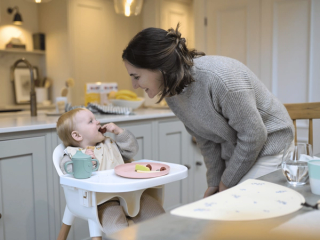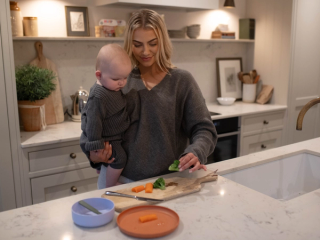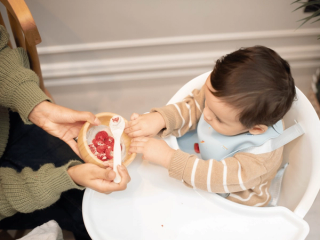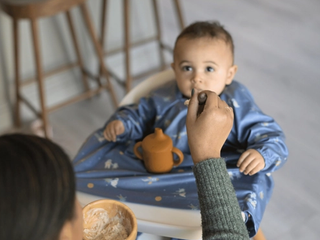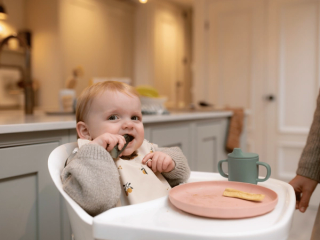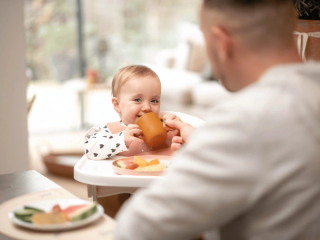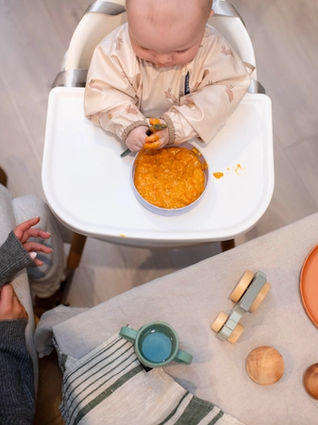
- Home
- Advice Hub
- Baby
- Weaning
- Baby Led Weaning Or Spoon Feeding?
Which type of weaning to choose – Baby Led Weaning or Spoon Feeding?
There are many important things to think about when you introduce solids to your baby, and whether your baby has a spoon in their hand or not is only one small part.
We want to start by saying that it doesn’t matter which type of weaning you decide to do (or more likely that your baby decides to do!). One of the most important parts of weaning is that it is enjoyable for everyone involved and that your baby has a positive start to their solid food journey.
Unfortunately, feeding is one of the areas in parenting where parents feel judged for the decisions they make, or the speed at which their baby is developing. Doing what is right for you, your baby and your circumstances is the best way to go. There are many important things to think about when you introduce solids to your baby, and whether your baby has a spoon in their hand or not is only one small part.
Spoon feeding
Spoon feeding is the introduction of purees from a spoon from the start of weaning, with the gradual transition from smooth purees through to mashed, minced and then chopped family foods.
In general, moving on from textures should be led by your baby’s ability rather than an age (much like when to start). If your baby is closing their mouth, swallowing easily then leaning forward with their mouth open for more, they may be ready to move on to more textures. You should aim to move through the textures as quickly as your baby seems able and should keep in mind that your baby should have moved on from purees by 9 months of age. This is because there may be an increased risk of fussy eating later in childhood if purees are given for too long.
Stage 1: purees and mashed foods
Stage 2: mashed foods with soft lumps
Stage 3: minced and chopped foods
There are different ways to increase the texture in your baby’s food. You could blend it less or stop blending all together and mash instead. Alternatively you could start to add some very small grains or mashed vegetables into the purees that you have. HiPP’s range of jars offers different textures, starting with smoother recipes at 4-6 months and moving onto foods with small soft lumps from 7 months.
Some of the benefits of spoon feeding include being able to offer a range of different foods with each spoonful, getting food in right from the start and being able to blend down and give foods that might otherwise be difficult to offer at first.
Negatives of spoon feeding are more based around the way it is done than negatives with the process itself. There can be a tendency to overfeed spoon-fed babies and some babies stay on purees for too long and do not eat as wide a range of textures as necessary to become skilled at eating. However, if you listen to your baby’s fullness cues, move through textures and ensure you give a good range of foods including finger foods, there is no reason for there to be any issues with your weaning journey.
Baby Led Weaning (BLW)
BLW involves your baby feeding themselves rather than you feeding with a spoon. It usually involves giving finger foods, but you can also put a pile of very thick puree in front of your baby and let them lick it off of their hands if you so wish!
The ethos behind BLW is really about giving your baby the independence to explore food and go at their own pace.
Whichever type of weaning you decide to use there are some key things you should think about:
BLW: things to consider
There is some research to show that babies weaning in this way eat more salt than spoon-fed babies. This is because normal family foods are often offered earlier and more regularly.
- There is some research to indicate that following BLW may help to reduce fussy eating later on in childhood1.
- BLW can encourage a more family approach to feeding so baby may be exposed to family dynamics and family foods earlier.
- You should never leave your baby alone whilst eating, but with BLW and finger foods this is particularly important.
- It can be more difficult to get all the essential nutrients into a baby who self feeds, as foods tend to be given individually rather than mixed together. You can always try spreading a puree such as our vegetable lasagne or our veg and sweet potato with chicken onto some finger foods. Your baby will enjoy licking and sucking the flavours even if they haven’t started biting and chewing yet. That said, we also don’t recommend you always give foods like ‘vegetable muffins’. Whilst these might be easy to eat and a good way to get vegetables into your baby, they don’t expose your baby to real foods or the type of family foods you will want them to eat in future.
Spoon feeding: things to consider
Spoon-fed babies sometimes grow at a faster rate than BLW. So if you’re spoon feeding make sure you’re feeding responsively so that your baby is only eating the amount that they want and need. This will help them to develop a healthy relationship with their food as they grow. You can read more about that HERE.
It can be easier to get a greater range of nutrients and textures into a spoon-fed baby because you are more in control of what is put into the mouth.
Can we do a mix of both?
Yes absolutely. Some parents worry that their child will become confused by doing some finger foods and some spoon feeding but this is absolutely fine. They are very different skills for your baby to learn, so it can be a good approach to let them learn both ways. You don’t have to do both at every meal, but across the week you may find opportunities where both would naturally occur.
Babies sometimes show a preference for spoon feeding or finger foods and it’s good to follow their lead rather than pushing them towards something they don’t enjoy. So trying a bit of both will allow your baby to learn both ways and you can just see how they get on.
If you think about the different types of foods that you eat across the day you can see how both methods can find their way into your baby’s mealtimes. Our baby porridge makes a perfect option for spoon feeding, but you may wish to give some toast fingers with hummus for lunch which makes a perfect finger food too.
Advice & tips

Want to read more? Join the HiPP BabyClub for full access to this article.
As a BabyClub member, you'll get access to a range of exclusive benefits, including:
Monthly competitions
Discounts from our Partners
Expert advice tailored to your little one's age
Weaning recipes
HiPP shop discounts*
*10% off HiPP's online shop does not apply to our First Infant, Anti-Reflux or Comfort Formula Milk.
Important notice: Breastfeeding is best. Follow on milk should only be used as part of a mixed diet from 6 months. Talk to a healthcare professional.




